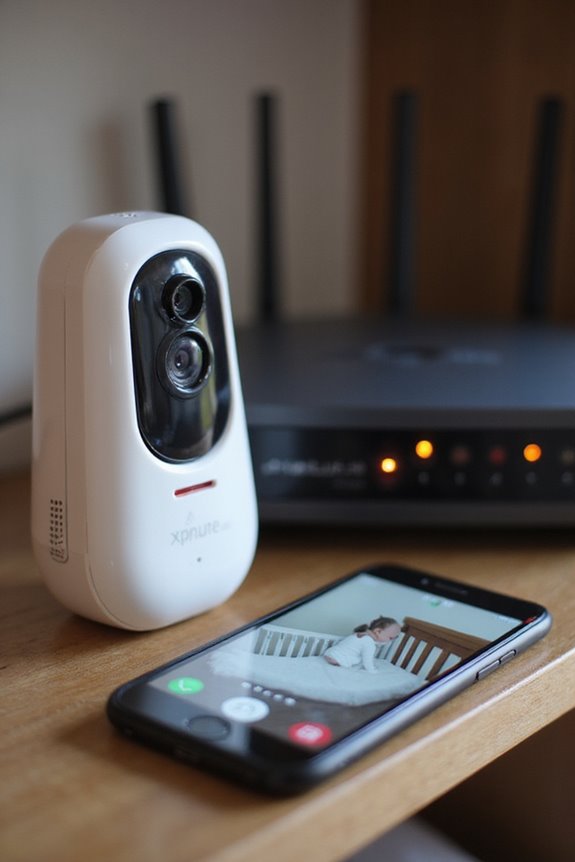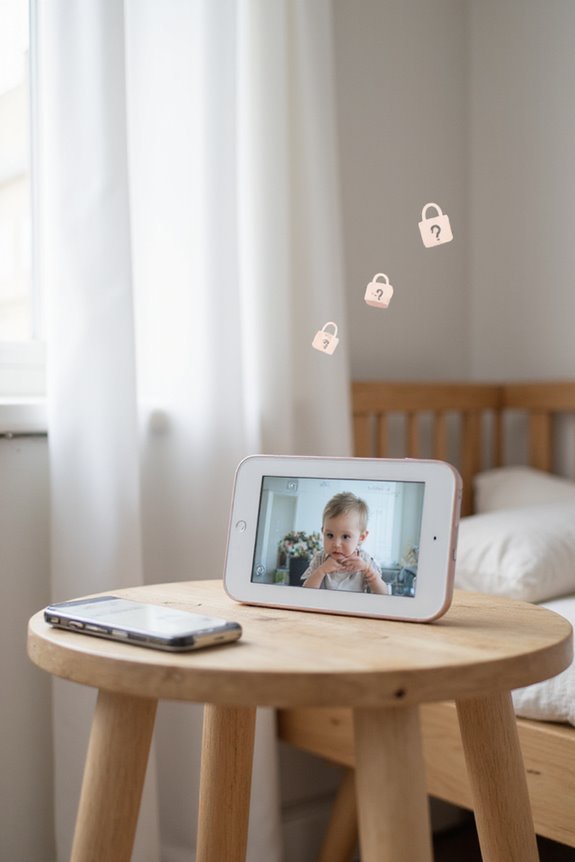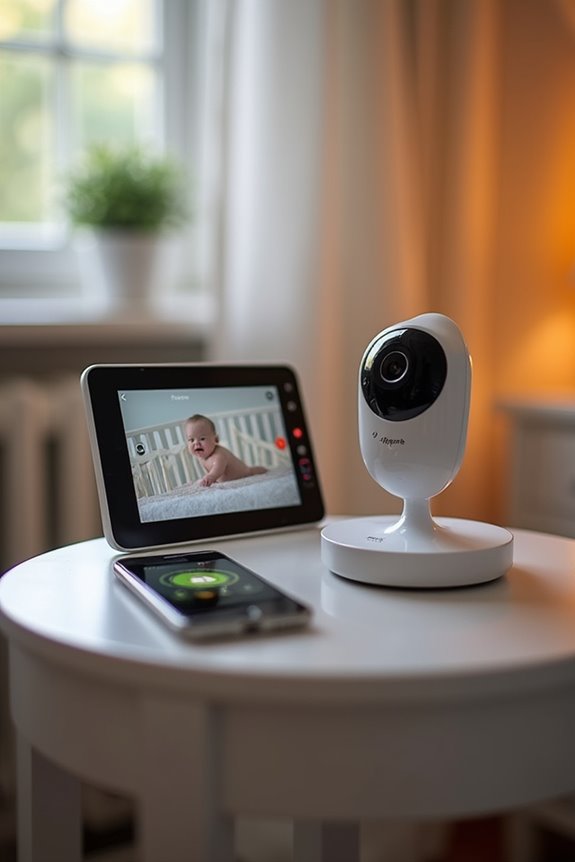Wi-Fi baby monitors exhibit significant security vulnerabilities, including outdated firmware, weak encryption, and unchanged default settings. These issues can lead to unauthorized access, privacy violations, and potential alterations to device settings that compromise safety. Hackers exploit poor configurations and lack of strong access controls, making these devices attractive targets. To enhance security, users should implement strong passwords, update firmware regularly, and isolate these devices on a separate network. Further insights on securing these monitors can provide additional guidance.
Key Takeaways
- Wi-Fi baby monitors often have outdated firmware, exposing them to known security vulnerabilities.
- Weak encryption methods can lead to easy data interception, compromising family privacy.
- Default usernames and passwords, if unchanged, allow unauthorized access to the device.
- Poor network configurations increase the risk of attacks on the monitor and connected devices.
- Implementing strong passwords and regular updates can significantly enhance the monitor’s security.
Common Security Vulnerabilities in Wi-Fi Baby Monitors
What factors contribute to the security vulnerabilities in Wi-Fi baby monitors?
Several critical issues can compromise the safety of these devices:
- Firmware Issues: Many monitors operate on outdated firmware, which exposes them to known vulnerabilities. This lack of regular updates allows unauthorized access through easily exploitable flaws.
- Encryption Flaws: Weak or absent encryption makes data interception straightforward. Without robust encryption protocols, sensitive information, including live feeds, becomes easily accessible to hackers.
- Insecure Communication Protocols: Use of outdated Wi-Fi technologies further exacerbates vulnerabilities, as they lack advanced security features, leading to potential data breaches.
Addressing these vulnerabilities is essential for ensuring the security of Wi-Fi baby monitors and protecting the privacy of users. Regular updates, strong encryption, and secure configurations are necessary steps.
Potential Risks From Hacked Wi-Fi Baby Monitors

The potential risks associated with hacked Wi-Fi baby monitors are significant, with implications for both privacy and safety. Unauthorized access can lead to:
- Privacy Violations: Live or recorded feeds may be intercepted, exposing families to unauthorized viewers, resulting in severe privacy implications.
- Emotional Distress: Parents may experience anxiety from unauthorized voices or movements, leading to diminished trust in technology designed for their children’s safety.
Additionally, hackers can manipulate device settings:
- Safety Risks: Altering alarm functions or motion sensors may create blind spots, compromising infant safety.
- Network Vulnerabilities: A compromised monitor can serve as a gateway to other devices, risking sensitive personal data.
These risks highlight the urgent need for robust security measures in Wi-Fi baby monitors.
Factors Making Wi-Fi Baby Monitors Less Secure

Although many parents rely on Wi-Fi baby monitors for enhanced surveillance of their infants, several factors compromise the security of these devices, increasing vulnerability to potential attacks.
Outdated Firmware and Software Vulnerabilities
- Many monitors operate on outdated firmware, exposing them to known security flaws.
- Lack of regular firmware updates leaves devices at risk long after vulnerabilities are identified.
Weak or Absent Encryption
- Some devices transmit data unencrypted, allowing unauthorized interception.
- Insufficient encryption compromises family privacy.
Default and Poor Access Controls
- Default usernames and passwords are often unchanged, making them easy targets.
- Many models lack strong access controls, facilitating unauthorized access.
Insecure Network Configurations
- Reliance on weak Wi-Fi security protocols increases exploitation risk.
- Poor network configurations leave devices vulnerable to attacks.
Methods Used by Hackers to Exploit Wi-Fi Baby Monitors

Methods used by hackers to exploit Wi-Fi baby monitors have become increasingly sophisticated, taking advantage of inherent security weaknesses. Key tactics include:
- Network Vulnerabilities: Weak configurations, such as default passwords, allow unauthorized access.
- Device Vulnerabilities: Exploiting software bugs in low-cost devices enables hackers to breach monitors.
- Centralized Server Attacks: Interception of data through centralized servers can compromise camera feeds.
- Outdated Protocols: Older communication protocols lack advanced security features, making them susceptible to breaches.
- Unsecured Access Controls: Missing proper authentication lets unauthorized users access devices.
These methods highlight significant risks to network security and illustrate the importance of addressing device vulnerabilities to guarantee safer monitoring for families.
Protective Measures to Enhance Wi-Fi Baby Monitor Security

Enhancing the security of Wi-Fi baby monitors is critical for safeguarding family privacy. Implementing secure settings begins with strong password management; unique, complex passwords should replace default ones immediately.
Router Security: Regularly update router firmware, disable unnecessary remote access, and employ WPA2 or WPA3 encryption.
Network Segmentation: Create a guest network for IoT devices, isolating them from primary devices to enhance security.
Device Security: Change default settings, enable two-factor authentication where possible, and apply firmware updates consistently.
Monitoring and Response: Conduct regular security checks and monitor network activity for suspicious behavior.
These protective measures collectively fortify Wi-Fi baby monitors, ensuring they serve their purpose without compromising family safety and privacy.
Summary of Security Findings and Expert Warnings
The security landscape surrounding Wi-Fi baby monitors reveals significant vulnerabilities that warrant urgent attention. Expert insights emphasize that many devices lack encryption, allowing hackers to intercept live feeds easily. Default passwords and insecure Wi-Fi networks further amplify risks, often leading to unauthorized access.
Key findings include:
- Outdated firmware exposes devices like the Mi-Cam to known vulnerabilities.
- Hackers can exploit communication channels, potentially invading family privacy and posing emotional distress.
- The potential for malicious communication with children is a critical concern.
User experiences highlight a loss of trust in technology following such breaches. Experts recommend using analog monitors, changing default settings, and conducting regular security audits to safeguard against these pervasive threats. Staying informed is essential to protecting sensitive devices.
Frequently Asked Questions
What Features Should I Look for in a Secure Baby Monitor?
When evaluating a secure baby monitor, one should prioritize encryption standards and user authentication features. These elements greatly enhance safety, ensuring a protected environment for both parent and child, fostering peace of mind and belonging.
How Can I Tell if My Monitor’s Firmware Needs an Update?
In the ever-evolving domain of technology, a baby monitor’s firmware update can be as crucial as a gentle lullaby. By steering through the monitor settings, one can reveal the need for essential updates, ensuring peak performance.
Are There Specific Brands Known for Better Security in Baby Monitors?
Certain brands, like Nest, are recognized for their robust security features, employing advanced encryption methods. Similarly, Motorola prioritizes strong encryption, ensuring parents feel secure while monitoring their little ones, fostering a sense of community and trust.
What Should I Do if I Suspect My Monitor Has Been Hacked?
If a monitor is suspected hacked, immediate action is essential; turning it off, disconnecting from the internet, and resetting the device are important for monitor security. Hacking prevention requires vigilance and regular security updates to guarantee safety.
Can Using a VPN Enhance the Security of My Baby Monitor?
Using a VPN can enhance baby monitor encryption, providing significant benefits such as secure data transmission and network protection. This added layer of security helps families feel safer and more connected in their parenting journey.



